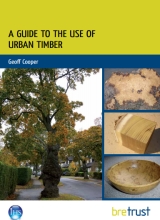A guide to the use of urban timber FB 50
BRE (Building Research Establishment) is an independent, research-based consultancy, testing and training organisation, operating in the built environment and associated industries.
A guide to the use of urban timber (FB 50) was written by Geoff Cooper and published by BRE on 31 July 2012.
Every day across the UK, thousands of tonnes of wood residue are produced through arboricultural work. However, the timber this produces is normally variable and inconsistent, resulting in problems with collection, transportation and selection. As a result, much of it is relegated to the much or firewood bin.
FB 50 is a 64-page illustrated guide to using timber from the UK’s urban timber resource, including street, park and urban woodland trees. It provides guidance on the selection and identification of high-value stems, as well as processing, drying, transport, storage and the logistical problems of dealing with felled material.
The guidance promotes the use of many common and exotic species for high-value solid wood products rather than being processed for firewood, chipped to produce mulch or sent to landfill. It is intended to help local authorities maximise the value of timber produced in towns and cities and to develop the best options for using solid wood produced during normal maintenance.
The contents of the guide are:
- Introduction.
- Material and species availability.
- Assessing stems for timber production.
- Value-added growth feature.
- A sawmill perspective.
- Timber dimensions, measurement and material grading.
- Wood drying.
- Air drying.
- The kiln drying of timber.
- Kiln drying processes.
- Drying schedules.
- Problems associated with wood drying.
- Calculating value.
- Identifying prospective markets.
- Appendix: Species list and wood property information.
- References.
[edit] Related articles on Designing Buildings Wiki
- 11 things you didn't know about wood.
- BRE articles on Designing Buildings Wiki.
- BRE Buzz articles on Designing Buildings Wiki.
- BRE Buzz.
- Building Research Establishment.
- Carpentry.
- Cat's paw figure.
- Definition of tree for planning purposes.
- Delivering sustainable low energy housing with softwood timber frame.
- Dunnage.
- End racking.
- Facts about forestry.
- Forest ownership.
- Forests.
- Physical Properties of Wood.
- Rip sawing.
- Ripple figure.
- Spalting.
- The differences between hardwood and softwood.
- Tiger-stripe figure.
- Timber preservation.
- Timber sticker.
- Timber vs wood.
- Timber.
- Tree preservation order.
- Tree rights.
- Types of timber.
- Urban trees.
- Waney edged.
Featured articles and news
The history of building regulations
A story of belated action in response to crisis.
Moisture, fire safety and emerging trends in living walls
How wet is your wall?
Current policy explained and newly published consultation by the UK and Welsh Governments.
British architecture 1919–39. Book review.
Conservation of listed prefabs in Moseley.
Energy industry calls for urgent reform.
Heritage staff wellbeing at work survey.
A five minute introduction.
50th Golden anniversary ECA Edmundson apprentice award
Showcasing the very best electrotechnical and engineering services for half a century.
Welsh government consults on HRBs and reg changes
Seeking feedback on a new regulatory regime and a broad range of issues.
CIOB Client Guide (2nd edition) March 2025
Free download covering statutory dutyholder roles under the Building Safety Act and much more.
AI and automation in 3D modelling and spatial design
Can almost half of design development tasks be automated?
Minister quizzed, as responsibility transfers to MHCLG and BSR publishes new building control guidance.
UK environmental regulations reform 2025
Amid wider new approaches to ensure regulators and regulation support growth.
The maintenance challenge of tenements.
BSRIA Statutory Compliance Inspection Checklist
BG80/2025 now significantly updated to include requirements related to important changes in legislation.
























